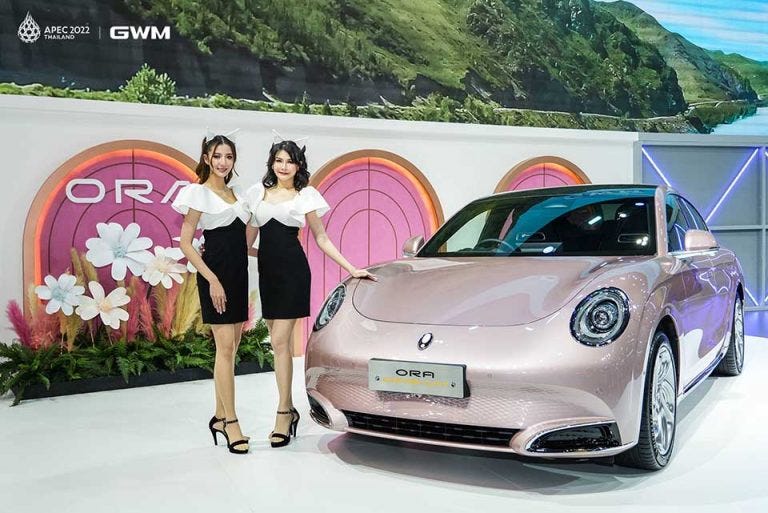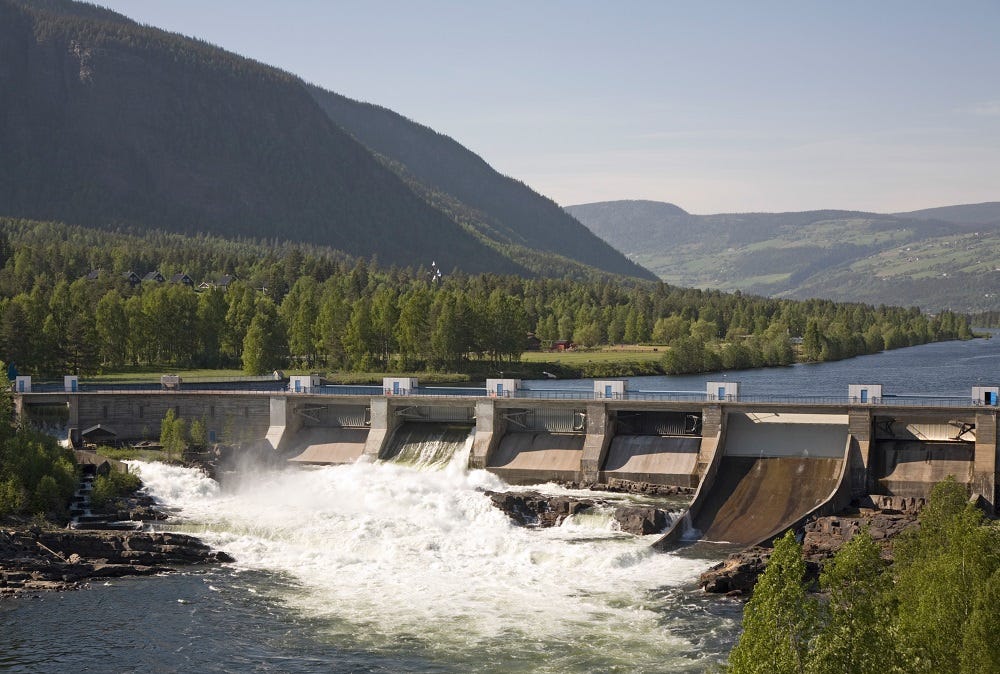EViscerated: ICE Vehicles are More Efficient than EVs
Even Norway's "green" hydropower electricity can't save EVs from the Laws of Physics
Above: spontaneous excitement is breaking out worldwide.
Preface: The End of EV Tyranny may be in Sight
It’s a lifestyle
Hello faithful readers, to start, I wish to acknowledge my co-author Van Snyder, a savvy veteran engineer who recently published an excellent book entitled “Where Will We Get Our Energy: A Comprehensive System Examination”, now available on Amazon. Van worked at Caltech Jet Propulsion Laboratory as a mathematician and software engineer for 53 years, directly on the Viking and Voyager projects.
In complement (I hope), my thermo and energy concepts are more grounded in the chemical processing and materials side of things, so it is always educational to collaborate with hands-on engineers such as Van, Nick Schoeder, and Richard Nielson.
We are part of a larger group of scientists and engineers known as: “The Truth Tellers of the Church of Microaggressions (TTCM)”, a name coined to deal with EV and Solar Cultists, and where we unabashedly present data that mostly contradicts popular green fetishes and beliefs. We are likely casting pearls before swine, but cannot give up the chance to possibly educate and elevate.
Above: Microagression short course, Part 1
On a more optimistic note, the end of the EV Tyranny appears to be upon us, as the reality wagon is hitched to unstoppable market forces - EVs just ain't selling because people now understand their drawbacks and can’t afford the Green Voodoo foisted upon them, especially so with the inflationary costs of electricity, fuel and other living essentials.
Even the mighty “Teflon Tesla” is suffering, as elucidated in the excellent article Tesla In Turmoil: The EV Meltdown In 10 Charts by Robert Bryce describing the latest downhill trajectory of Tesla and the EV industry in general.
The EV Tyranny in Europe is also under pressure as people have become “woke” to the EV drawbacks sans subsidies, most glaringly in Norway, Land of the EV Mega-Subsidies and clean hydropower, the ultimate focus of this article.
Despite these breakthroughs, magical thinking remains resilient within the USA Blue Bubble Zones, usually amongst a tech heavy and cash rich demographic who are in a better position to fund the Chinese Battery Industry, and make money from their BlackRock portfolios, in stark contrast with the Average Joe & Jane who are just trying to make ends meet in the brutal age of Inflation.
In parallel, an EV and solar “wealth transfer” has occurred, from the lower and middle classes to the upper classes, simply due to the brutal taxation of the masses which feeds the “Inflammation Reduction Act” green mandates and subsidies.
These policies predominantly benefit the Left Coast, the denizens of which proudly display roofs adorned with solar panels and Rivians in their driveways; and who view inflation as a minor nuisance at best. My guess is that Rivian will go bust like most of the other smaller EV manufacturers, and we will continue to face an avalanche of solar panels and EV e-waste in the coming years.
Above: Celexa by script available or in Mexico no script.
Numbers don’t lie. Belief and hope will not change the Law’s of Physics and Thermodynamics, even as Greta thrashes about and gets arrested for the umpteenth time. Setting the stage, and in brief review, a prior article also linked below suggested that ICE vehicles are more efficient than EVs, as revealed via the VW EV emissions scandal, in which VW covered up the true environmental and economic costs of EVs by pulling the studies off the internet. We surmised that the VW articles were pulled because the results were bad for business.
The VW EV scandal article also showed that even with pure hydropower as the electricity source in lala Norway, the so-called CO2 breakeven point may be about 30,000 miles of driving, while with a rest of the world energy mix, people will have to gruel out 78,000 miles in their EV.
So basically you gotta drive those miles to neutralize the large excess of CO2 produced to build the EV, mostly derived from the battery manufacturing.
Finally, in that article, we showed that if every car in the world was replaced with an EV, it would not make any real dent in CO2 emissions anyway, and would possibly increase CO2. Remarkably, this conclusion was easily reached using simple arithmetic and data from EPA, DOE and other data consolidators.
So what's New?
We now present: “EViscerated: ICE Vehicles are More Efficient than EVs”, which is another title for the lightly edited but true to form version of The Norwegian Illusion, a piece published by the market driven folks at the investment firm Goehring and Rozencwajg, and reproduced with their permission here.
So without further adieu, we present the “final stake in the EV heart”, with this slight spoiler: even though electric motors are 90 % efficient, and the ICE is only about 30-40 % efficient, the EV cradle to grave losses and upstream inefficiencies cannot overcome the direct fuel burn of an ICE vehicle, even with electrons derived from pure hydropower or natural gas. Yes, a bona fide EVisceration.
The Norwegian Illusion: Why ICE Cars are More Efficient than EVs
Above: assuming the position Norwegian Style.
Starting mid-point last decade, the investment community became convinced EV adoption would quickly surge. EV penetrations would become so great that global oil consumption would imminently peak, or so consensus opinion widely believed. 2019 was repeatedly referenced as the year that oil demand would peak and then decline. In retrospect, these concerns were misplaced. Despite the massive COVID-19 disruption, oil demand in 2024 should reach 103 m b/d – 2.3 m b/d greater than 2019. Undeterred by the surprising surge in demand, many analysts remain convinced that “peak oil demand” is still imminent. The investment community’s belief that EVs will displace the internal combustion engine remains as strong as ever. We vigorously disagree.
In our last letter, we predicted that global energy demand would consistently exceed expectations for the next twenty years. Never before have so many people been simultaneously in their period of energy-intensive economic development. Our essay focused broadly on total energy demand and specifically avoided oil consumption. Our choice was deliberate: we wanted to highlight the critical drivers of total energy demand and avoid getting distracted by the debate on EV penetration. Today’s essay focuses on oil and explains why we believe demand will surprise the upside for years to come.
Our research shows that EVs will struggle to achieve widespread adoption despite massive subsidies and the growing threat of outright internal combustion engine (ICE) bans.
After carefully studying the history of energy, we have yet to find an example where a new technology with inferior energy efficiency has replaced an existing, more efficient one.
Despite claims to the contrary, our research suggests EVs are less energy efficient than internal combustion engine automobiles. As a result, they will fail to gain widespread adoption. Our claim is controversial; most pundits insist EVs are far more efficient. We believe the ICE is clearly the winner once the energetic costs of both the battery and the renewable power required to make “carbon-free” EVs are considered.
Above: assuming the position, again.
Although governments can encourage EVs through either subsidies or ICE bans, these measures will likely fail, as consumers will ultimately refuse to embrace a new technology that sports inferior energy efficiency. Better examples couldn’t exist than Ford and Hertz dramatically scaling back their EV initiatives due to lower-than-expected consumer interest.
Mitigating carbon emissions is central to the case for electric vehicles. Advocates argue that displacing fossil fuels is essential to curbing global warming. We disagree. Replacing ICEs with EVs will materially increase carbon emissions and may worsen the problem. Manufacturing an electric vehicle consumes far more energy than an ICE. Most of this additional energy is spent mining the materials for and manufacturing an EV’s giant lithium-ion battery. Mining companies use energy-intensive trucks, crushers, and mills to extract each battery’s nickel, cobalt, lithium, and copper. The manufacturing process consumes vast amounts of energy as well. Many analysts eagerly tout the carbon savings from displaced fossil fuels without adequately accounting for the battery’s increased energy consumption. Once these adjustments are made, most, if not all, of the EV’s carbon advantage disappears.
Above: another hellish 3rd world day mining for cobalt.
If our models are correct, EVs will fail on two fronts: they are less energy efficient than the ICEs they are trying to replace and their adoption will do little to mitigate carbon emissions.
Policymakers often tout Norway as the ultimate EV success story. Thanks to massive subsidies, EVs made up 80% of all Norwegian new car sales in 2022 and currently account for 20% of the total car fleet. Policymakers hope all developed countries will ultimately adopt Norway’s model. However, upon closer inspection, Norway's experience does more to warn of EVs’ shortcomings than advocate for their adoption.
The first problem is financial. The Norwegian government offers consumers massive subsidies to purchase an EV. New vehicles are exempt from several onerous taxes and the 25% VAT. On average, a large new ICE would be subject to $27,000 in various taxes; an equivalent EV would pay none. Next, Norway exempts EVs from any road or ferry tolls and allows them to use bus lanes, offers free parking and charging in municipal areas, and ensures “charging rights” in apartment buildings. Although Norway rolled back some of these operating subsidies starting in 2017, an Oslo resident can still expect these benefits to total $8,000 annually.
Norway is one of the wealthiest countries in the world, with a per capita GDP of $106,000 in 2022. Despite its impressive wealth, the government must still financially incentivize its citizens to purchase EVs.
The benefits are starting to take their toll on Norway’s finances. At nearly $4 billion annually, Norway spends as much on EV subsidies as on total highway and public infrastructure maintenance (!).
The program has also raised significant issues around equality in Norway. EV subsidies favor high-income urban citizens, who take advantage of free tolls, parking, and charging and avoid the onerous tax on larger luxury vehicles. Several populist-leaning political groups in Norway have made so-called “elitist” EV subsidies a focal point of their platform.
Above: fairy tale perfection in Norway.
Amid growing scrutiny, the government has actively sought to reduce several subsidies. Municipal parking is no longer free, and passengers (although not the vehicles themselves) are subject to certain tolls. The government also introduced a partial purchase tax on new EVs. Proponents have warned that any rollback of subsidies will surely harm EV penetration and offer Sweden as a case study, where, in 2022, the elimination of several subsidies precipitated a 20% drop in EV sales.
More important, EVs in Norway have not affected fossil fuel demand or carbon emissions as expected. Although oil demand and carbon emissions have fallen by 15% since 2010, most of this is unrelated to EV sales. Over the period, total oil demand fell by only 34,000 b/d, with gasoline and diesel making up a mere 10% of the decline. Most of the decline came from heating, lighting, and petrochemical demand, which we estimate collapsed by more than a third. Despite 20% of all vehicles on the road now being electric, Norway’s gasoline and diesel demand fell by a mere 4%.
Our data suggests that Norwegians are reluctant to give up their ICE vehicles, even after purchasing an EV. We calculate that two-thirds of Norway’s EV households own at least one ICE vehicle. From 2010 to 2022, Norway added 550,000 EVs, but the number of ICE vehicles on the road, rather than falling, increased by 32,630. While the population grew by 11%, the total number of passenger cars grew by 25%. When an EV household prefers to avoid a road or ferry toll, have access to free parking or charging, or avoid congestion by using bus lanes, they use their EV. When they visit their hytte in the mountains, they use their ICE. The impact has been so material that advocates have lobbied for a government-funded ICE scrappage program,- another veiled EV subsidy.
Unsurprisingly, electricity demand has surged as Norway shifted from fossil fuels to electricity for transportation, heating, and lighting. Since 2010, Norwegian electricity demand rose an impressive 20%. Total primary demand for all forms of energy increased by 5%. The data suggests that a widespread shift to EVs did little to reduce overall energy consumption despite claims they are far more efficient. The shift from fossil fuels to electricity has reduced Norway’s CO2 by an impressive 16%, an achievement lauded in the press. Far less discussed, however, is how the US lowered its emissions by 16% over the same period, by switching from coal to natural gas in its power generation.
Using Norway as a model for CO2 reduction would be a mistake. Far more than any other country in the world, Norway benefits from its vast hydrological potential which generates nearly 92% of all electricity carbon-free. Therefore, a move from fossil fuels towards electricity will significantly impact Norway’s carbon emissions more than anywhere else on Earth.
Furthermore, Norway imports all domestic EVs. As we discussed, EV manufacturing is incredibly energy-intensive, mainly to build the battery. In Norway’s case, none of this additional energy is reflected in their domestic demand figures. China manufactures most lithium-ion batteries and 80% of all EVs. Coal accounts for 60% of their total energy supply.
Above: flood of EVs made in China bound for Europe.
We estimate an average EV consumes 60 MWh to manufacture, of which the battery represents half. Therefore, manufacturing Norway’s 579,000 EVs (all the EVs on the road today in Norway) requires 35 twh, equivalent to 25% of the total annual Norwegian electricity demand. Given that China emits 600 grams of CO2 per kwh (China is where almost all of Noway’s EV batteries are manufactured), we calculate Norway’s EV fleet would emit 21 mm tonnes of CO2. Norway’s gasoline and diesel consumption fell by a meager 3,200 barrels per day or 50 mm gallons per year. Assuming 9 kg of CO2 per gallon of gasoline or diesel, Norway’s entire EV fleet mitigates a mere 450,000 tonnes of CO2 per year, compared with an upfront emission of 21 mm tonnes. In other words, it would take forty-five years of CO2 savings from reduced gasoline and diesel consumption to offset the initial emissions from the manufacturing of the vehicles.
Since an EV battery has a useful life of only ten to fifteen years, it is clear that Norway’s EV rollout has increased total lifecycle CO2 emissions dramatically. Incredibly, this is true despite Norway having the lowest carbon hydroelectricity in the world. Even if China were to reach its overly ambitious targets for wind, solar, and nuclear power by 2035, we calculate that the carbon “payback” would still exceed twenty years.
Realistically, the only way for EVs to reduce lifecycle carbon emissions would be with a widespread move to carbon-free energy in EV manufacturing. Most EV advocates hope renewable energy will be the solution. Unfortunately, we do not believe this will prove feasible due to their inferior energy efficiency.
Above: Norway hydropower.
Instead of serving as a model, Norway’s program should warn of the unintended consequences of large-scale EV penetration, particularly when consumers purchase an EV in addition to an ICE. Countless articles claim EVs are far more energy efficient than ICE vehicles. Moreover, these authors argue EVs will be more efficient and more carbon-free once renewables replace coal and natural gas. Our analysis, unpopular and controversial, suggests the opposite.
Most articles list EVs as anywhere between two and three times more energy efficient than the ICEs they replace. The basis for this claim is that internal combustion engines are only 40% efficient and that nearly 60% of the energy contained in gasoline or diesel fuel is “wasted,” –mainly in the form of heat and friction. On the other hand, an electric motor transfers nearly 90% of its electrical energy directly to the wheels. The difference leads many to erroneously conclude that an EV is almost three times as “efficient” as an ICE.
This common argument is fundamentally flawed for three reasons. First, it fails to capture the energy needed to make the battery; second, it fails to distinguish between thermal and electric energy; and third, it fails to account for the poor energy efficiency of renewable energy.
An EV uses 32 kWh of electricity per 100 miles traveled. The vehicle’s battery, meanwhile, consumes an incredible 24 MWh in its manufacturing. Assuming a useful life of 120,000 miles, the battery pack consumes 20 kWh per 100 miles traveled, two-thirds as much as the direct electricity itself. Most analysts we have read fail to include this onerous energy burden when touting the EV’s superior efficiency.
Next, most efficiency arguments fail to distinguish between thermal and electrical energy. While most of us have been taught that energy is fungible, several distinct forms of energy have differing degrees of usefulness. Although it is beyond the scope of this essay, the distinction surrounds the randomness, or entropy, of the energy carrier. Burning fuels of any kind always creates high entropy. Electricity, on the other hand, with its orderly string of moving electrons, has low entropy.
“Upgrading” from thermal to electric energy always introduces predictable inefficiencies based on the fundamental laws of thermodynamics. When pundits claim an EV is three times more efficient than an ICE, they fail to make this distinction.
In a combustion engine, the driver converts gasoline into forward motion with approximately 30-40% efficiency, with high entropy by-products such as water vapor, CO2 and waste heat. Electricity drives a motor with approximately 90% efficiency in an electric vehicle. However, electricity does not exist in nature but instead must be generated. Burning natural gas (high entropy) to generate electricity (low entropy) is only 40-50% efficient. The EV is not inherently more efficient; instead, the inefficient “upgrade” from thermal to electric energy occurs off-stage and is conveniently omitted by most analysts.
Last, most efficiency arguments fail to account for energy generation in the first place. For example, as we saw with Norway, the only way to lower automotive carbon emissions is by converting to renewable energy for both the manufacturing and powering of the vehicle. Unfortunately, renewable power is prohibitively inefficient. This may be surprising. After all, neither wind nor solar “burn” fuel, and so are not subjected to the inefficiency of moving from thermal to electric energy discussed earlier. However, wind and solar suffer from incredibly low energy density (consider the heat from a gas stove compared to a stiff breeze). To capture useful quantities of power, windmills must stand 300 m tall, and solar farms must spread out over thousands of acres. These large installations require raw materials like steel, cement, copper, silver, and polysilicon. These materials, in turn, consume vast quantities of energy to both mine and process. By comparison, oil and gas extraction is highly efficient.
We study the total energy required to produce various forms of energy, a metric known as energy return on investment (EROI). While a single unit of invested energy might generate fifty units of (thermal) energy over the life of a productive oil well, it will only generate ten units of (electrical) energy with wind or less than six from a solar panel. Furthermore, wind and solar power must be buffered by grid-level battery storage to avoid intermittency, which requires far more energy. Fully buffered wind likely has an EROI of six to seven, while solar may be as low as three. Claiming a renewable-powered EV is efficient because its motor operates at 90% fails to account for the poor upstream efficiency.
Instead, we have taken a completely different approach when calculating automotive efficiency: assuming 100 kWh of available thermal energy, how far can a driver expect to travel in an ICE compared with an EV. We prefer this methodology, as it aligns with our intuitive understanding of “efficiency:”: how much can we get out of a single unit of energy. Using this approach, the race isn’t even close --the ICE wins “hands down.”
An efficient ICE can expect to achieve 37 miles per gallon of gasoline or 98 kWh of thermal energy per 100 miles. The vehicle components require 20 MWh, or 15 kWh per 100 miles, when amortized over a useful life of 170,000 miles—according to Argonne Labs. The ICE can expect to consume 112 kWh per 100 miles, of which 90% represents thermal energy in the form of gasoline. Oil extraction benefits from a very high EROI of 60:1 at the wellhead. In other words, 60 units of thermal energy, in the form of crude, comes up the wellbore for every unit of energy invested. Transportation and refining consume approximately 15% of the energy contained in the crude, lowering the EROI to 50. To be conservative, we are assuming an ultimate EROI of 45. Therefore, investing one kWh of thermal energy will create 45 kWh of thermal energy, propelling the ICE 41 miles.
A modern EV consumes 32 kWh of direct electrical energy per 100 miles. The battery requires an additional 24 MWh, which over the vehicle’s useful life of 120,000 miles equals 20 kWh per 100 miles. The remaining vehicle components consume 27 kWh per 100 miles. The EV can expect to consume 80 kWh per 100 miles, of which 95% is electricity.
Assuming the electricity is generated in a natural gas-fired power plant, the EROI is approximately 25 once transmission line losses are considered. Starting again with one kWh of thermal energy, we would expect to generate 25 kWh of electricity. The EV would, therefore, travel 32 miles – 20% less than the ICE. If electricity is generated using a mixture of unbuffered wind and solar, the EROI could be as low as 13. Therefore, one kWh of energy would only generate 13 kWh of electricity, propelling the EV a mere 16 miles – over 60% less than the ICE.
Never in history has a less efficient “prime mover” displaced a more efficient one. We believe this time will be no different. While governments may try to coerce drivers into buying EVs or even ban ICE altogether, these policies will ultimately fail as consumers insist on keeping their more efficient vehicles.
Disclaimer: Goehring & Rozencwajg Associates, LLC. The information provided is intended to provide the investor with an introduction to Goehring & Rozencwajg Associates, LLC. Nothing on this website should be construed as a solicitation offer, or recommendation to buy or sell any security or as an offer to provide advisory services. Information on this website is intended only for United States citizens and residents. Nothing contained on this website constitutes investment, legal, tax, or other advice nor should be relied upon in making an investment or other decision. Investors should always obtain and read an up-to-date investment services description or prospectus before deciding whether to appoint an investment advisor or to invest in a fund.
This material may include estimates, outlooks, projections and other “forward-looking statements.” Due to a variety of factors, actual events or market behavior may differ significantly from any views expressed. Investing entails risks, including possible loss of principal. Investments concentrated in natural resources involve a higher degree of risk than more diversified strategies. Past performance is no guarantee of future results.
Investment process, strategies, philosophies, portfolio composition and allocations, security selection criteria and other parameters are current as of the date indicated and are subject to change without prior notice.
Neither rankings nor recognitions by unaffiliated rating services, publications, media, or other organizations, nor the achievement of any professional designation, certification, degree, or license, membership in any professional organization, or any amount of prior experience or success, should be construed by a client or prospective client as a guarantee that the client will experience a certain level of results if the investment professional or the investment professional’s firm is engaged, or continues to be engaged, to provide investment advisory services. A fee was not paid by either the investment professional or the investment professional’s firm to receive the ranking. The ranking is based upon specific criteria and methodology (see ranking criteria/methodology-to the extent applicable). No ranking or recognition should be construed as an endorsement by any past or current client of the investment professional or the investment professional’s firm.
Certain links may let you leave the Adviser’s website. The linked websites are not under the control of the Adviser, and we are not responsible for the content of any linked website, or any link contained in a linked website, or any changes or updates to such websites. Adviser is providing these links to you only as a convenience, and the inclusion of any link does not imply endorsement, investigation, verification or monitoring by us of such third-party website. Any references to outside data, opinions or content are listed for informational purposes only and have not been verified for accuracy by the Adviser. Third-party views, opinions or forecasts do not necessarily reflect those of the Adviser or its employees.
Unless stated otherwise, any mention of specific securities or investments is for illustrative purposes only. Adviser's clients may or may not hold the securities discussed in theri portfolios. Adviser makes no representations that any of the securities discussed have been or will be profitable.


















Doesn't it seem the *most* desirable ICE is the one that is long-lived and repairable? So many cars are nearly irreparable because whole (expensive) modules need to be replaced instead of a mechanics ministrations. So, even modern ICEs with their over-reliance on gadgetry (and the planned obsolescence inherent in electronica) are a horror show. Why can't we just have cars from the year 2000, with some hypermiling tech sprinkled in?
Great article. Your calculations regarding the carbon consequences of Norwegian electric cars are quite enlightening. As long as car batteries are largely manufactured using Chinese coal, it is difficult to call Electric vehicles “Green.”
A small quibble with your assumption: “Burning natural gas (high entropy) to generate electricity (low entropy) is only 40-50% efficient.” The latest CCGT plants offer efficiencies of 64+%. This would substantially lower the disadvantage of EVs, and potentially entirely make up the gap.
https://www.gevernova.com/gas-power/products/gas-turbines/h-class-gas-turbines